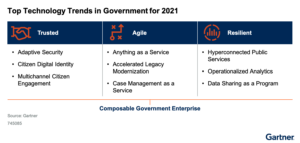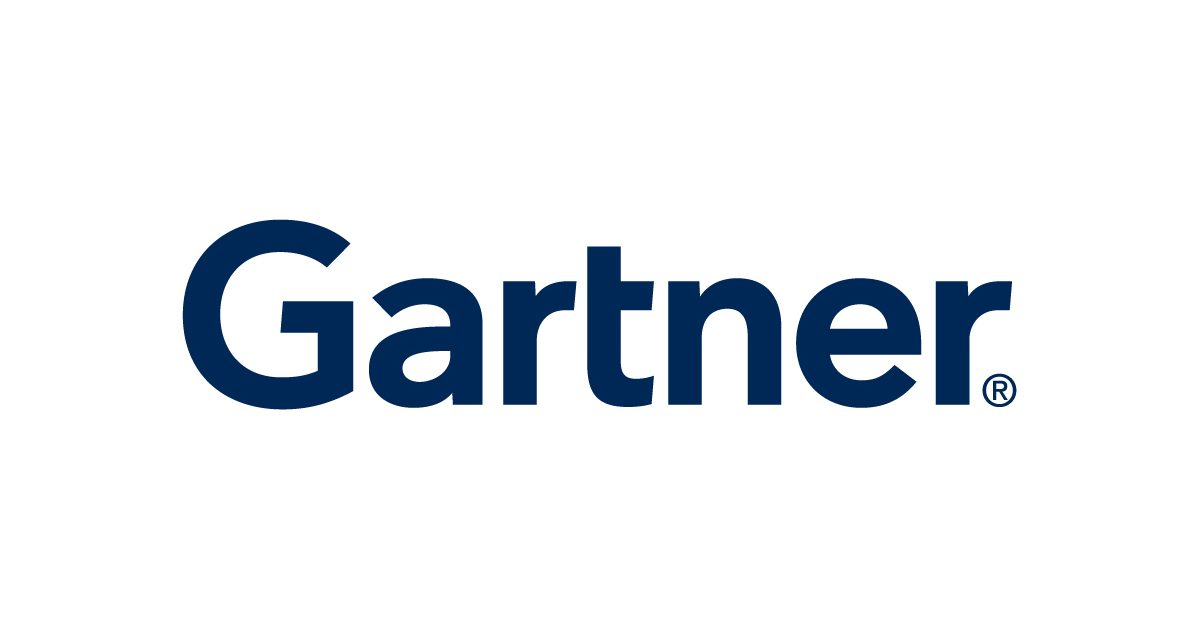Top Trends Address Critical Security, Cost Containment and Citizen Experience Challenges in the Public Sector

Gartner, Inc. has identified the top 10 government technology trends for 2021 that have the potential to accelerate digital innovation and optimize or transform public services.
Gartner’s top 10 strategic technology trends for government this year arise from the challenges wrought from the pandemic and the need for flexible operating models that support significant disruptions.
“The COVID-19 pandemic has spurred the acceleration of digital innovation across the government sector around the world, presenting government leaders with new opportunities to use data and technologies to build trust, agility and resilience in public institutions,” said Rick Howard, research vice president at Gartner. “While pandemic-related challenges will continue for some time, technology trends have emerged that address critical challenges in areas such as security, cost containment and citizen experience.”
Gartner’s list of strategic technology trends is directly linked to public administration and policy issues that government leaders must address. Government CIOs can use this list to identify technology trends that best address their post-pandemic recovery priorities and establish the rationale, timing and priority of technology investments.
Accelerated Legacy Modernization
Governments have experienced the limitations and risks posed by decades-old legacy infrastructure and core systems. To be better equipped to deal with the next disruption, government CIOs are accelerating the move to modern, modular architectures. While the need for legacy modernization is not new to government CIOs, the challenges related to the pandemic have only served to heighten the awareness of the resulting risks and the need for it.
Gartner predicts that by 2025, over 50% of government agencies will have modernized critical core legacy applications to improve resilience and agility.
Adaptive Security
An adaptive security approach treats risk, trust and security as a continuous and adaptive process that anticipates and mitigates constantly evolving cyber threats. This approach features components for prediction, prevention, detection and response. It forgoes traditional notions of perimeter, assuming there is no boundary for safe and unsafe, a necessary conceptual shift given the migration to cloud services.
Gartner predicts that 75% of government CIOs will be directly responsible for security outside of IT by 2025, to include operational and mission-critical technology environments.
Anything as a Service (XaaS)
XaaS is a cloud-only sourcing strategy that embraces acquiring the full range of business and IT services on a subscription basis. Pandemic response and the critical need for digital service delivery have exacerbated pressures to modernize legacy applications and infrastructure. XaaS offers an alternative to legacy infrastructure modernization, provides scalability and reduces time to deliver digital services.
Gartner predicts that 95% of new IT investments made by government agencies will be made as a service solution by 2025.
Case Management as a Service (CMaaS)
Case work is the predominant workstyle of government, with the entire legacy-heavy portfolio of monolithic case management point solutions found in many departments. CMaaS is a new way to build institutional agility by applying composable business principles and practices, to replace legacy case management systems with products that can be rapidly assembled, disassembled and recomposed in response to changing business needs.
Gartner predicts that by 2024, government organizations with a composable case management application architecture will implement new features at least 80% faster than those without.
Citizen Digital Identity
Digital identity is the ability to prove an individual’s identity via any government digital channel that is available to citizens, which is critical for inclusion and access to government services. Digital identity ecosystems are quickly evolving and leading governments to assume new roles and responsibilities. The topic is high on political agendas, so government CIOs must link digital identity to salient use cases.
Gartner predicts that a true global, portable, decentralized identity standard will emerge in the market by 2024, to address business, personal, social and societal, and identity-invisible use cases.
Composable Government Enterprise
The composable government enterprise is any government organization that adopts composable design principles. This enables them to extend the reuse of capabilities and continuously adapt to changing regulatory, legislative and public expectations. CIOs are embracing composable government to overcome existing, siloed approaches to managing services, systems and data that limit the ability of governments to adapt to the rapidly evolving needs of the emerging digital society.
Gartner predicts that 50% of technology companies that provide products and services to the government will offer packaged business capabilities to support composable applications by 2023.
Data Sharing as a Program
Data sharing is often ad hoc in government, driven by high-profile use cases such as child protection incidents or gender violence that cannot easily be generalized. Data sharing as a program moves it into being a scalable service, with multiple reusable capabilities, supporting the drive toward more composable approaches in government service delivery.
Gartner predicts by 2023, 50% of government organizations will establish formal accountability structures for data sharing, including standards for data structure, quality and timeliness.
Hyperconnected Public Services
Hyperconnected public services is the whole-of-government use of multiple technologies, tools or platforms to automate as many business and IT processes as possible. Government CIOs can use hyperautomation principles and practices to develop hyperconnected, highly automated end-to-end business processes and public services that require minimal human intervention.
Gartner predicts that by 2024, 75% of governments will have at least three enterprise-wide hyperautomation initiatives launched or underway.
Multichannel Citizen Engagement
Citizen direct participation with governments reached new heights in 2020 as communities dealt with the pandemic, wildfires, hurricanes and other events. Multichannel citizen engagement is a seamless, bidirectional engagement with constituents across organizational boundaries, while delivering a personalized experience using the preferred and most effective channels to reach them.
Gartner predicts that over 30% of governments will use engagement metrics to track quantity and quality of citizen participation in policy and budget decisions by 2024.
Operationalized Analytics
Operationalized analytics is the strategic and systematic adoption of data-driven technologies, such as artificial intelligence (AI), machine learning and advanced analytics, at each stage of government activity to improve the efficiency, effectiveness and consistency of decision making. Decision makers can make better context-based operational decisions in real-time to improve the quality of the citizen experience.
Gartner predicts that by 2024, 60% of government AI and data analytics investments aim to directly impact real-time operational decisions and outcomes.
Gartner clients can learn more in the report “Top Technology Trends in Government for 2021” and in the companion report “Top Business Trends in Government for 2021.”
Learn more about emerging trends, expected challenges and next steps for CIOs and IT leaders in the free Gartner E-Book “Top Priorities for IT: Leadership Vision for 2021.”
About the Gartner Information Technology Practice
The Gartner IT practice provides CIOs and IT leaders with the insights and tools to drive the organization through digital transformation to lead business growth. Additional information is available at https://www.gartner.com/en/information-technology. Follow news and updates from the Gartner IT practice on Twitter and LinkedIn using #GartnerIT.
สิบอันดับเทคโนโลยีสำหรับภาครัฐที่โดดเด่นประกอบด้วย เทคโนโลยีด้านความปลอดภัย การควบคุมค่าใช้จ่าย และการจัดการความท้าทายด้านประสบการณ์ของประชาชนต่อภาครัฐ

การ์ทเนอร์ อิงค์ เผย 10 แนวโน้มเทคโนโลยีในกิจการภาครัฐในปี 2564 ที่มีศักยภาพเร่งกระบวนการสร้างสรรค์นวัตกรรมดิจิทัลและสามารถนำมาปรับใช้ได้อย่างมีประสิทธิภาพหรือเปลี่ยนโฉมการให้บริการสาธารณะ
10 อันดับแนวโน้มเทคโนโลยีนี้ เกิดมาจากความท้าทายต่าง ๆ ที่หน่วยงานภาครัฐต่าง ๆ ต้องเผชิญระหว่างการแพร่ระบาดและความต้องการรูปแบบการดำเนินงานที่ยืดหยุ่นเพื่อรับมือกับการเปลี่ยนแปลงที่มีผลกระทบใหญ่หลวงต่าง ๆ
มร. ริค ฮาวเวิร์ด รองประธานฝ่ายวิจัยของการ์ทเนอร์ อิงค์ กล่าวว่า “การระบาดของโควิด-19 กระตุ้นให้องค์กรภาครัฐทั่วโลกเร่งพัฒนานวัตกรรมดิจิทัล ซึ่งทำให้ผู้บริหารภาครัฐมองเห็นโอกาสใหม่ ๆ ในการใช้ข้อมูลและเทคโนโลยีมาสร้างความไว้วางใจ เสริมความคล่องตัวและเพิ่มความยืดหยุ่นด้านการดำเนินงานในหน่วยงาน ในขณะที่ความท้าทายจากการแพร่ระบาดจะยังมีต่อไปอีกระยะหนึ่ง แต่ก็มีแนวโน้มของเทคโนโลยีที่ช่วยรับมือความท้าทายระดับวิกฤตเกิดขึ้น อาทิ เทคโนโลยีด้านความปลอดภัย เทคโนโลยีการควบคุมต้นทุนและเทคโนโลยีเพื่อให้ประสบการณ์ที่ดีสำหรับประชาชนผู้ติดต่อหรือใช้บริการจากหน่วยงานราชการ”

เทคโนโลยีทั้งหมดนี้ล้วนเชื่อมโยงโดยตรงกับการบริหารงานของภาครัฐและการกำหนดนโยบายที่ผู้บริหารหน่วยงานต่าง ๆ ในรัฐบาลต้องจัดการและให้ความสำคัญ ผู้บริหารด้านไอทีของภาครัฐฯ สามารถพิจารณาเพื่อกำหนดทิศทางในการนำเทคโนโลยีมาปรับใช้เพื่อวางแผนการฟื้นตัวหลังการระบาดของโรค พร้อมกำหนดเงื่อนไข ระยะเวลา และจัดลำดับความสำคัญในการลงทุนด้านเทคโนโลยีได้อย่างมีประสิทธิภาพที่สุด
การเร่งปรับปรุงระบบให้ทันสมัย
หน่วยงานภาครัฐฯ ต่าง ๆ ประสบกับข้อจำกัดและความเสี่ยงที่เกิดจากโครงสร้างพื้นฐานและระบบหลัก ๆ ที่ใช้สืบต่อกันมานับสิบปี เพื่อการเตรียมความพร้อมรับมือที่ดียิ่งขึ้นกับการหยุดชะงักครั้งต่อไป ซีไอโอภาครัฐฯ ควรเร่งผลักดันการเปลี่ยนผ่านไปสู่สถาปัตยกรรมโมดูลาร์ที่ทันสมัย ในขณะที่ความจำเป็นในการปรับปรุงระบบแบบเดิมให้ทันสมัยไม่ใช่เรื่องใหม่สำหรับซีไอโอของรัฐบาลแต่คือความท้าทายที่เกี่ยวกับการแพร่ระบาดของโรคที่ควรตะหนักให้มากขึ้นถึงการป้องกันยับยั้งและความเสี่ยงที่เกิดขึ้น
การ์ทเนอร์คาดว่าภายในพ.ศ. 2568 หน่วยงานภาครัฐกว่า 50% จะปรับปรุงพัฒนาแอปพลิเคชันหลักที่สำคัญให้ทันสมัยเพื่อให้มีความยืดหยุ่นและความคล่องตัวในการใช้งาน
เทคโนโลยีเพื่อความปลอดภัยที่ปรับตัวได้ตามสภาวะการณ์
แนวทางการรักษาความปลอดภัยแบบปรับได้มองว่าความเสี่ยง ความไว้วางใจและความปลอดภัยเป็นกระบวนการที่ต่อเนื่องและปรับได้ซึ่งเป็นการเตรียมการและบรรเทาภัยคุกคามทางไซเบอร์ที่ไม่เคยหยุดอยู่กับที่ แนวทางนี้นำเสนอองค์ประกอบต่าง ๆ เพื่อการคาดการณ์ ป้องกัน ตรวจจับและตอบสนอง โดยมองข้ามขอบเขตของแนวคิดเดิม ๆ ด้วยสมมุติฐานว่าเรื่องของความปลอดภัยและไม่ปลอดภัยนั้นไม่มีขอบเขตสิ้นสุด ซึ่งนี่เป็นแนวคิดสำคัญในการโยกย้ายไปสู่การบริการคลาวด์
การ์ทเนอร์คาดการณ์ว่าภายในพ.ศ. 2568 75% ของซีไอโอภาครัฐฯ จะมีหน้าที่รับผิดชอบโดยตรงต่อความปลอดภัยที่อยู่นอกเหนือขอบเขตของเทคโนโลยีสารสนเทศ รวมถึงการปฏิบัติการและภารกิจที่สำคัญยิ่งยวดต่อสภาพแวดล้อมด้านเทคโนโลยี
การให้บริการทุก ๆ อย่างแบบ XaaS (Anything as a Service)
การให้บริการทุก ๆ อย่าง แบบ XaaS (Anything as a Service) คือกลยุทธ์การจัดหาบริการต่าง ๆ บนคลาวด์โดยเฉพาะ ซึ่งรวบรวมบริการทางธุรกิจและไอทีแบบครบวงจรในรูปแบบของการสมัครสมาชิก (Subscription Basis) การตอบสนองต่อโรคระบาดและความจำเป็นเชิงวิกฤตต่อบริการดิจิทัลทำให้เกิดแรงกดดันมหาศาลในการปรับปรุงแอปพลิเคชันและโครงสร้างพื้นฐานเดิมให้ทันสมัย XaaS ให้ทางเลือกในการปรับปรุงโครงสร้างพื้นฐานแบบเดิม ๆ ให้ทันสมัย เพิ่มความสามารถในการปรับขนาดและย่นระยะเวลาในการส่งมอบบริการดิจิทัลต่าง ๆ
ภายในพ.ศ. 2568 การ์ทเนอร์คาดการณ์ว่า 95% ของการลงทุนใหม่ ๆ ไปกับเทคโนโลยีสารสนเทศของหน่วยงานภาครัฐจะถูกกำหนดให้เป็นรูปแบบของโซลูชันการบริการ
บริการสำหรับการจัดการเป็นรายกรณี (Case Management as a Service)
งานบริการสังคม (Case work) เป็นรูปแบบการทำงานหลัก ๆ ของรัฐบาลด้วย รูปแบบโซลูชั่นการจัดการรายกรณีแบบเดิม ๆ พบได้ในหลายหน่วยงาน การจัดการเป็นรายกรณี (CMaaS) เป็นรูปแบบการทำงานใหม่ที่เพิ่มความคล่องตัวของหน่วยงานโดยใช้หลักการและแนวปฏิบัติทางธุรกิจแบบผสมผสานเพื่อแทนที่ระบบการจัดการเคสแบบโบราณด้วยโซลูชั่นประกอบรวมเข้าด้วยกันหรือแยกส่วนและประกอบใหม่ได้อย่างรวดเร็วเพื่อตอบสนองต่อความต้องการทางธุรกิจที่เปลี่ยนไป
การ์ทเนอร์คาดว่าภายในพ.ศ. 2567 หน่วยงานภาครัฐต่าง ๆ ที่มีสถาปัตยกรรมแอปพลิเคชันการจัดการรายกรณีแบบผสมผสานจะนำฟีเจอร์ใหม่ ๆ มาใช้ได้เร็วกว่าหน่วยงานที่ไม่มีสถาปัตยกรรมดังกล่าว อย่างน้อย 80%
ข้อมูลประจำตัวประชาชนแบบดิจิทัล
ข้อมูลประจำตัวประชาชนแบบดิจิทัล คือความสามารถในการระบุอัตลักษณ์ของบุคคลผ่านช่องทางดิจิทัลของภาครัฐที่มีให้ประชาชนซึ่งมีความสำคัญอย่างมากในการเข้าถึงและได้รับบริการต่าง ๆ ของรัฐ ระบบนิเวศข้อมูลประจำตัวดิจิทัลกำลังพัฒนาไปอย่างรวดเร็วและจะนำพาให้ภาครัฐไปสู่บทบาทและความรับผิดชอบใหม่ ๆ หัวข้อนี้เป็นวาระการเมืองขั้นสูงดังนั้น ซีไอโอภาครัฐต้องเชื่อมโยงข้อมูลประจำตัวดิจิทัลกับกรณีที่สำคัญ
ภายในพ.ศ. 2567 การ์ทเนอร์คาดการณ์มาตรฐานการระบุอัตลักษณ์อย่างแท้จริงจะเป็นแบบกระจายศูนย์ การเก็บข้อมูลมีความสะดวก เรียกใช้ได้จากทุกที่และเคลื่อนย้ายได้ ทั้งนี้เพื่อจัดการกับกรณีการใช้งานในระดับธุรกิจ บุคคล สังคม และการระบุแบบไร้ตัวตน
การผสานรวมองค์กรภาครัฐ
การผสานรวมขององค์กรภาครัฐคือหน่วยงานภาครัฐใด ๆ ที่ใช้หลักการออกแบบผสมผสาน ซึ่งช่วยให้เพิ่มความสามารถด้านการทำงานซ้ำและปรับตัวเข้ากับการเปลี่ยนแปลงของกฎระเบียบ กฎหมายและความคาดหวังของประชาชนได้อย่างต่อเนื่อง ซีไอโอกำลังนำการผสานรวมภาครัฐมาใช้เพื่อเอาชนะวิธีการจัดการบริการ ระบบและข้อมูลที่มีอยู่ซึ่งจำกัดความสามารถของรัฐบาลในการปรับตัวให้เข้ากับความต้องการที่เปลี่ยนแปลงอย่างรวดเร็วของสังคมดิจิทัลที่กำลังเกิดขึ้น
ภายในปี 2566 การ์ทเนอร์คาด 50% ของบริษัทเทคโนโลยีที่จัดหาผลิตภัณฑ์และบริการให้กับภาครัฐจะเสนอความสามารถทางธุรกิจแบบแพ็กเกจเพื่อรองรับแอปพลิเคชันการผสานรวม
สร้างโปรแกรมการแบ่งปันข้อมูล
ภาครัฐมักแบ่งปันข้อมูลแบบเฉพาะกิจ โดยเน้นเรื่องที่ประชาชนให้ความสนใจสูง เช่น เหตุการณ์การคุ้มครองเยาวชนหรือเหตุความรุนแรงทางเพศที่มีความละเอียดอ่อนและมีความซับซ้อน ซึ่งการสร้างโปรแกรมแบ่งปันข้อมูล (Data Sharing as a Program) ทำให้การบริการสามารถปรับขนาดได้ตามต้องการ โดยสามารถนำกลับมาใช้ใหม่ได้ในหลายรูปแบบ ซึ่งสนับสนุนการให้บริการภาครัฐเพื่อขับเคลื่อนไปสู่แนวทางที่ทำงานแบบผสมผสานกันได้มากขึ้น
ภายในปี 2566 การ์ทเนอร์คาด 50% ขององค์กรภาครัฐจะสร้างโครงสร้างการแบ่งปันข้อมูลที่มีความรับผิดชอบอย่างเป็นทางการรวมถึงมาตรฐานโครงสร้างข้อมูล คุณภาพและความตรงต่อเวลา
การบริการสาธารณะแบบไฮเปอร์คอนเนค (Hyperconnected)
การเชื่อมต่อสาธารณะแบบไฮเปอร์คอนเนคคือการใช้เทคโนโลยีหลากหลายที่ภาครัฐใช้ทั้งหมดรวมถึงเครื่องมือหรือแพลตฟอร์มที่ทำให้กระบวนการทางธุรกิจและไอทีเป็นอัตโนมัติมากที่สุด ซีอีโอของภาครัฐสามารถใช้หลักการผสานรวมเทคโนโลยี (Hyperautomation) และแนวปฏิบัติแบบไฮเปอร์คอนเนคเพื่อพัฒนากระบวนการทางธุรกิจและบริการสาธารณะแบบต้นน้ำถึงปลายน้ำในรูปแบบอัตโนมัติมากที่สุดโดยลดการใช้แรงงานคนให้น้อยที่สุด
ภายในปี 2567 การ์ทเนอร์คาดการณ์ว่า 75% ของภาครัฐจะเปิดตัวหรือดำเนินการโครงการริเริ่มหลักการผสานรวมเทคโนโลยี (Hyperautomation) ทั่วทั้งองค์กรอย่างน้อย 3 โครงการ
การมีส่วนร่วมของประชาชนในหลากหลายช่องทาง
ประชาชนมีส่วนร่วมโดยตรงกับกิจการภาครัฐมากขึ้น และแตะจุดสูงสุดในปี 2563 จากการร่วมกันรับมือภัยการแพร่ระบาดครั้งใหญ่ เหตุการณ์ไฟป่า พายุเฮอริเคนและเหตุการณ์อื่น ๆ การมีส่วนร่วมของประชาชนในหลากหลายช่องทางเป็นไปอย่างราบรื่น ซึ่งมีส่วนร่วมแบบสองทิศทางตามขอบเขตขององค์กร ในขณะเดียวกันก็ส่งมอบประสบการณ์ส่วนบุคคลโดยใช้ช่องทางที่ต้องการและมีประสิทธิภาพมากที่สุดในการเข้าถึงประชาชน
การ์ทเนอร์คาดการณ์ว่ารัฐบาลกว่า 30% จะใช้มาตรการชี้วัดการมีส่วนร่วมเพื่อติดตามปริมาณและคุณภาพการมีส่วนร่วมของประชาชน เพื่อนำมาใช้ตัดสินใจวางแผนด้านนโยบายและงบประมาณภายในปี 2567
การวิเคราะห์เชิงปฏิบัติการ
การวิเคราะห์เชิงปฏิบัติการคือการนำเทคโนโลยีที่ขับเคลื่อนด้วยข้อมูลมาใช้อย่างมีกลยุทธ์และเป็นระบบเช่น ปัญญาประดิษฐ์ (AI) การเรียนรู้ของเครื่องจักร (Machine Learning) และการวิเคราะห์ขั้นสูง (Advanced Analytics) โดยในแต่ละขั้นตอนของกิจกรรมภาครัฐเป็นไปเพื่อพัฒนาประสิทธิภาพ ประสิทธิผลและช่วยการตัดสินใจให้ดีขึ้น ซึ่งผู้มีอำนาจสามารถตัดสินใจดำเนินงานตามบริบทได้ดีขึ้นแบบเรียลไทม์เพื่อพัฒนาคุณภาพของประสบการณ์ประชาชนให้ดีขึ้น
ภายในปี 2567 การ์ทเนอร์คาดการณ์ 60% ของการลงทุนด้านการวิเคราะห์ข้อมูลและ AI ของภาครัฐมีจุดมุ่งหมายเพื่อสร้างแรงกระเพื่อมโดยตรงต่อผลลัพท์และการตัดสินใจแบบเรียลไทม์
ลูกค้าการ์ทเนอร์สามารถคลิกอ่านรายงานเพิ่มเติมได้ที่ “Top Technology Trends in Government for 2021” และในรายงานควบคู่กัน “Top Business Trends in Government for 2021.”
เรียนรู้เพิ่มเติมเกี่ยวกับเทรนด์ที่เกิดขึ้นใหม่ ความท้าทายที่คาดหวัง และก้าวต่อไปของซีไอโอและผู้นำด้านไอทีในการ์ทเนอร์อีบุ๊ค “Top Priorities for IT: Leadership Vision for 2021.”
เกี่ยวกับแนวปฏิบัติด้านเทคโนโลยีสารสนเทศของการ์ทเนอร์
แนวทางการปฏิบัติด้านไอทีของการ์ทเนอร์ช่วยให้ซีไอโอและผู้นำด้านไอทีมีข้อมูลเชิงลึกและเครื่องมือในการขับเคลื่อนองค์กรผ่านการเปลี่ยนแปลงทางดิจิทัลเพื่อนำไปสู่การเติบโตทางธุรกิจ
ดูข้อมูลเพิ่มเติมได้ที่ https://www.gartner.com/en/information-technology ติดตามข่าวสารและข้อมูลอัปเดตจากแนวปฏิบัติด้านไอทีของ Gartner บน Twitter และ LinkedIn ได้ที่ #GartnerIT


